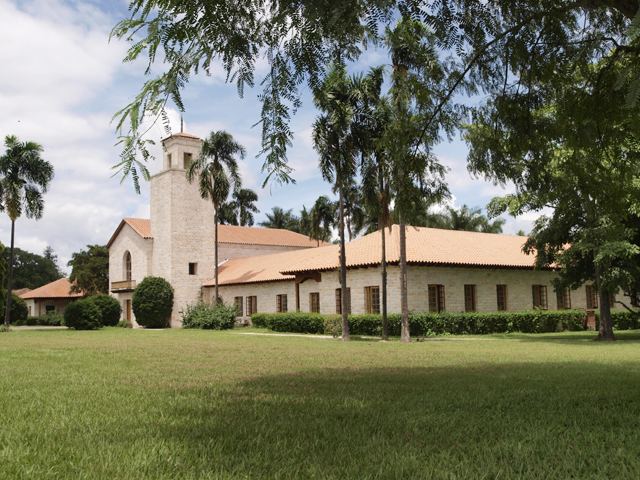Established 1942 Dean Dr. Raul Zelaya Undergraduate tuition and fees 19,285 USD (2017) Total enrollment 1,282 (2016) Founded 1942 | Rector Dr. Jeffrey Lansdale Students 1,253 (2016) Phone +504 2287-2000 Founder Sam Zemurray | |
 | ||
Type Educational Institution nonprofit Address Apartado Postal 93, Km 30 carretera de Tegucigalpa a Danlí Valle del Yeguare, Municipio de San Antonio de Oriente. Francisco Morazán, Honduras., Tegucigalpa 11101, Honduras Similar Universidad Nacional Autónom, Central American Technolo, Escuela Nacional de Cienci, Universidad José Cecilio d, Universidad Nacional de Agricu Profiles | ||
The Zamorano Pan-American Agricultural School (Spanish: Escuela Agrícola Panamericana Zamorano), generally known as El Zamorano or Zamorano, is a private, coeducational university located in the valley of the Yeguare river, Honduras. El Zamorano's main focus is agricultural and there are four different programs to choose from in the school. Enrollment stands at more than 1000 students. It is currently registered in Delaware as a 501(c)3 non-profit organisation.
Contents
- Horticulture innovation lab regional center at zamorano julio l pez zamorano
- History
- Programs
- Campus
- Library
- Publications
- Enterprises
- Former Rectors
- Distinguished Alumni
- Alumni Organizations
- References
Zamorano is host to students from diverse countries (Honduras, Guatemala, El Salvador, Nicaragua, Costa Rica, Panama, Ecuador, Peru, Colombia, Chile, Bolivia, Dominican Republic, Paraguay, México and more).
Horticulture innovation lab regional center at zamorano julio l pez zamorano
History
The school was founded in 1941 by Samuel Zemurray (1877–1961) a Russian born American and president of the United Fruit Company. Mr. Zemurray set out to create a high quality agricultural education centre, devoted to the training of youth from throughout the region. To carry out this dream, he recruited Dr. Wilson Popenoe, a renowned botanist and horticulturist of the time who had extensive experience in the region, and had already organised the famous Lancetilla Botanical Gardens in Honduras.
Popenoe travelled for several weeks in 1941, exploring the Central American highlands to develop the project. He finally chose an estate of approximately 15 km² in the valley of the Yeguare, some 30 kilometres from the Honduran capital. The name Zamorano is that of the family from the province of Zamora, Spain that originally owned the estate.
Construction of the school began in late 1941. Dr. Popenoe became the Founding Director of the new institution and held that post until 1957. Since then, the small school has grown to become what is today a university centre of excellence serving the Americas and the world.
Programs
Campus
The university is located on a large campus of great natural beauty, colourful gardens and quite singular architecture. The entire property lies on some 70 km², including natural forests and two micro basins, large productive areas, many places for recreation and various buildings. There are green areas, paths and lagoons harbouring numerous wild species that have found natural shelter on the Zamorano campus.
Zamorano has many areas/spots that are host to species that are both native to the region and exotic from all over the tropical world. Thanks to its long and distinguished tradition in biological science research, Zamorano currently has one of the largest herbaria in Latin America. The Paul Standley Herbarium hosts close to 300,000 classified specimens from Meso-America that are available to the students. Its collection of pests and beneficial insects is also in the neighbourhood of 200,000 specimens. Many are the result of research done by Zamorano's specialists and the contributions of its students.
The campus is home to more than 1000 resident students on the campus eleven months of every year. An area of 200,000 m² is set aside for student dorms. An area of 70,000 m² is used for various aspects.
Library
Zamorano has one main library, the Wilson Popenoe Library. This library has a diverse collection of books for the education of the students and scientific research. It has over 18,000 specialised books, 6,500 technical brochures, access to online databases worldwide, digital documents and a considerable number of magazines.
Publications
Enterprises
The enterprises are the university's production, processing and marketing units, where the students learn by doing. Working in the enterprises is an integral part for the formation of each student and takes up about half of their time. The enterprises provide the physical resources and the right environment where the student develops skills and knowledge that prepare them for their future careers. The University Enterprises are living labs where the students face what has been learned in the classroom and confront it with the real world and in doing so improve their learning process. The University Enterprises are distributed into three main groups: agriculture, animal husbandry and processing plants. There is also a marketing and sales unit in which students are actively involved, interacting with customers and the market. The agriculture group is made up of the agricultural units for horticulture, orchards, forestry and grains and seed. The animal husbandry group includes livestock units in dairy and beef cattle, swine production and a support unit in agricultural machinery and irrigation. The processing plants group consists of plants for processing dairy and meat products, animal feeds, seed production, fruit and horticultural products, post-harvest care of horticultural products and a sawmill. Each business unit is managed by means of an agribusiness plan and agro-budget so that operations are handled as a company with financial and educational goals.
Former Rectors
Distinguished Alumni
Many Zamorano alumni have achieved important roles within governments, NGO's, non-profit organisations, universities, and large multi-national companies. Some of the most notable alumni include: Jose Antonio Molina (Botanist, Honduras '46), Marcel Laniado (Banker, Ecuador '49), Carlos Eduardo Mesa Mesa (Business Magnate, Colombiano), Eduardo Galo (Novus International Director of North America, Honduras '95)
